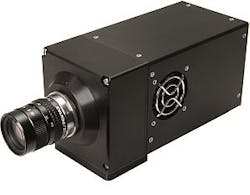This InGaAs SWIR camera delivers 640 × 512 pixel resolution with extended dynamic range response up to 2.2 µm. It can detect voids, cracks, and dead areas through silicon and capture faint electroluminescence and photoluminescence emissions from individual photovoltaic cells. Peak quantum efficiency is >70 % at 1100 nm and >65% from 1000 to 1600 nm, input pixel size is 25 × 25 µm, and responsivity is 1.2 and 31 µV per electron in low- and high-gain mode, respectively. The camera operates at 25 fps at full resolution at 10 MHz and has a 16-bit extended dynamic range. Other applications include industrial thermal imaging, imaging spectroscopy, thick sample and tissue IR microscopy, laser profiling, telecommunications, and low-light-level and range-gated IR imaging.
Photonic Science Ltd.
Robertsbridge, England
[email protected]
More Products
-----
PRESS RELEASE
Infrared (SWIR/ InGaAs) camera for high-throughput solar cell inspection
ROBERTSBRIDGE, UK, April, 2011 — Photonic Science Ltd. has introduced a high-resolution InGaAs short-wavelength infrared (SWIR) camera for high-throughput solar cell inspection using laser-induced fluorescence. It delivers 640 × 512-pixel resolution with extended dynamic range response up to 2.2 µm.
The camera detects voids, cracks and dead areas through sliced and bulk silicon and captures faint laser fluorescence-induced emissions from individual photovoltaic cells and bare silicon wafer substrates. Cracks, and dead or weak responding areas are unveiled on sliced wafers, enabling automatic sorting and selection of the best pieces at up to >3000 wafers/h.
It captures faint electroluminescence and photoluminescence emissions from individual photovoltaic cells that are directly proportional to their efficiency. Peak quantum efficiency is >70 % at 1100 nm and >65% from 1000 to 1600 nm.
Features include a high-responsivity InGaAs sensor, low-noise electronics and deep cooling. The read-while-expose mode enables a 100% shutterless duty cycle and high sensitivity operation in low-light-level conditions. Input pixel size is 25 × 25 µm, responsivity in low-gain mode is 1.2 µV per electron and, in high-gain-mode, 31 µV per electron. The camera operates at 25 fps at full resolution at 10 MHz and has a 16-bit extended dynamic range.
Supplied with state-of-the-art SWIR optics, it delivers high resolution and contrast modulation and lower distortion than the conventional near-infrared optics that are used with CCD cameras. Other applications include astronomy, industrial thermal imaging, imaging spectroscopy, thick sample and tissue infrared microscopy, laser profiling, telecommunications, and low-light-level and range-gated infrared imaging.
-----
Follow us on Twitter
Subscribe now to Laser Focus World magazine; it's free!
